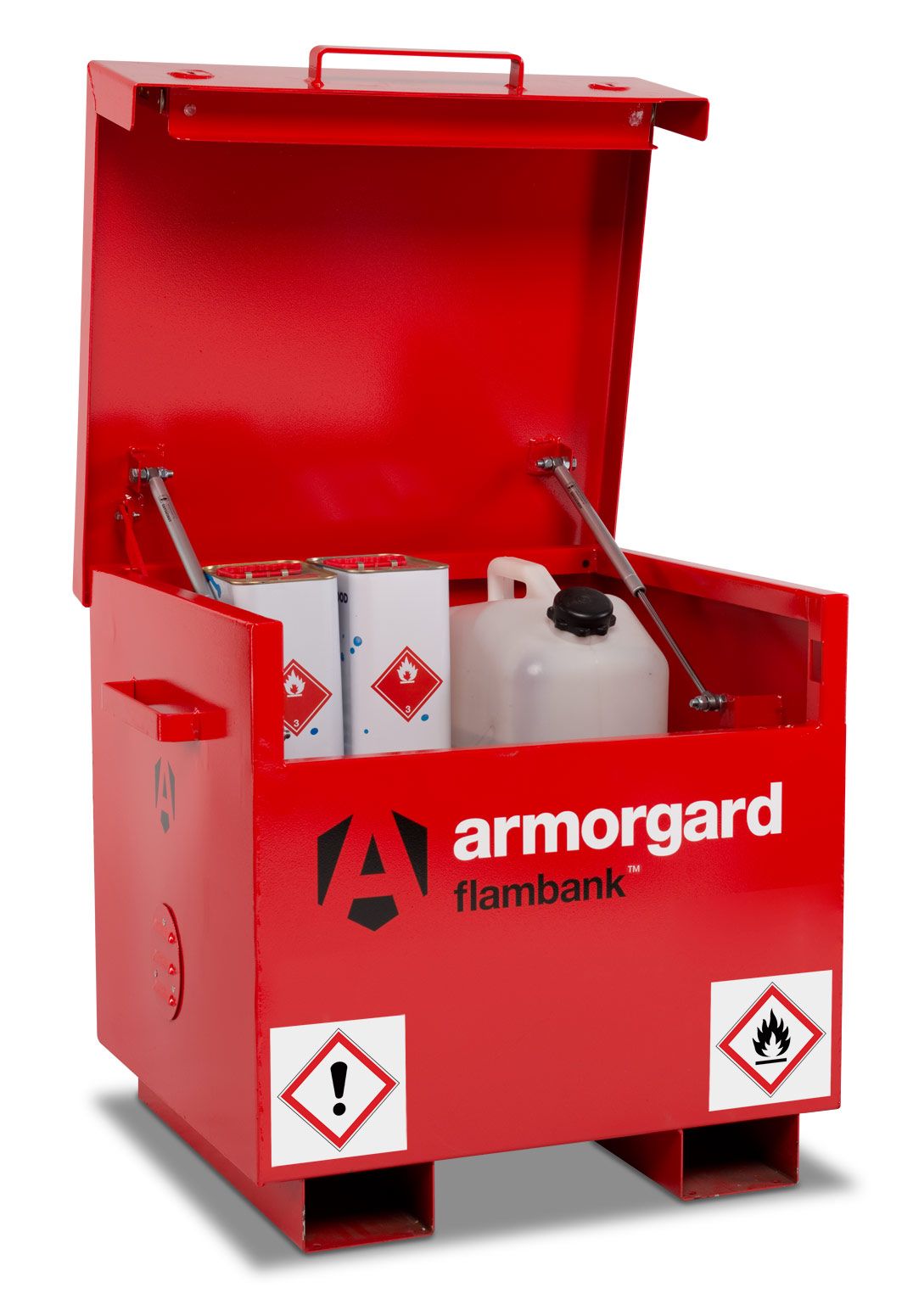A Guide to Safe Storage of Hazardous Substances in Manufacturing
For manufacturers, the safe storage of hazardous substances is a critical aspect of maintaining a secure and healthy work environment. Failure to properly store and handle these substances can result in harm to employees, the surrounding environment and costly penalties or legal consequences.
In this guide from the workplace safety experts at SafetyBuyer, we will highlight all of the essential factors to take into consideration in order to ensure that any hazardous substances you use on site can be stored safely, in line with the relevant health and safety legislation.
By understanding and implementing the practices outlined in this guide, businesses will not only comply with the necessary health and safety regulations, but also ensure that their employees and the environment are properly protected from potential harm.
How are hazardous substances used in manufacturing?
As a rule, health regulations dictate that businesses should take steps to reduce or eliminate the use of hazardous substances in their working processes wherever possible. For manufacturers, this is not always feasible, as many hazardous substances play a crucial and irreplaceable role in various manufacturing processes. They can be found in the raw materials processed during manufacturing, in the cleaning agents used to maintain equipment, and in the byproducts produced during manufacturing processes.
From flammable substances used as solvents and cleaning agents to corrosive materials used in plating and etching, these substances are essential for producing a wide range of products. However, they also pose potential dangers to human health and the environment if not managed responsibly, which is why the proper storage and handling of these chemicals are crucial to minimise potential risks and comply with health and safety regulations.
The improper storage and handling of hazardous substances can result in serious consequences for workers and others on site, ranging from discomfort to permanent damage, or even fatalities in the most serious cases. Employers have a responsibility to control exposure and protect the wellbeing of their workers by managing these risks; by doing so, they can ensure that everyone is being kept safe, even when potentially dangerous substances need to be used on a regular basis.
The challenges associated with storing hazardous substances
Storing hazardous substances presents unique challenges that must be addressed to maintain a safe working environment. These challenges include:
- Ensuring proper labelling and handling procedures
- Preventing leaks and spills<
- Maintaining appropriate storage conditions
- Managing the risks of extreme temperatures, impact damage and security issues
Segregation, temperature control, and ventilation are crucial aspects of hazardous substance storage. Segregation prevents incompatible substances from being stored together, reducing the risk of hazardous reactions. Temperature control ensures that substances are stored at the appropriate temperature, preventing degradation or instability. Ventilation is necessary to prevent excessive levels of fumes or hazardous gases from accumulating in the storage area.
Another challenge is ensuring that hazardous substances are easily identifiable and accessible only to those who are trained to handle them. This involves clear labelling and secure storage, with reference to the relevant safety data sheet for each product.
Using hazardous substances incorrectly can have serious consequences on our health, including skin and respiratory problems, severe irritation, poisoning and even death. Therefore, it is important to take extra precautions and always follow safety guidelines when handling any hazardous material; only by doing so can businesses ensure that they have properly controlled all of the foreseeable risks associated with the use of these hazardous chemicals on site.
What are the COSHH regulations and compliance issues involved in storing hazardous substances?
To ensure a safe working environment and comply with health and safety regulations, employers must adhere to the Control of Substances Hazardous to Health (COSHH) regulations when storing hazardous substances. These regulations, developed and overseen by the Health and Safety Executive (HSE), require employers to assess risks, determine control measures, and follow a hierarchy of control measures to minimise potential harm associated with the use of COSHH substances.
Carrying out risk assessments
Conducting a COSHH risk assessment is an essential step in managing hazardous substances in the workplace. The assessment should consider factors such as the work conditions, safe handling, storage, transportation of hazardous substances, and appropriate waste removal.
The process typically involves identifying potential hazards, determining who could be affected and how, assessing the risks, establishing necessary precautions, documenting the findings, implementing necessary changes, and regularly reviewing and evaluating the assessment.
Implementing control measures
Once potential hazards have been identified and assessed, it is crucial to implement control measures to minimise risks associated with hazardous substances. Control measures may include the elimination of a substance, substitution of a hazardous substance with a safer alternative, establishment of a restricted work area, and comprehensive training of employees to ensure they are wearing protective clothing and following the necessary safety regulations when dealing with dangerous chemicals and other substances.
Additionally, businesses are bound to follow the COSHH regulations while determining the amount of hazardous substances necessary for operations. They also need to maintain safety data sheets, providing important information about the properties of the substance, its health and environmental hazards, and the necessary protective measures, in accordance with the manufacturer's instructions.
By following the hierarchy of control measures outlined in the COSHH regulations, businesses can effectively manage the risks associated with hazardous substances and maintain a safe working environment. Adhering to these regulations and implementing safe storage practices can help businesses to protect their employees and avoid legal penalties.
Safe storage practices for hazardous substances
Here, we will break down some of the most crucial specific steps that manufacturing businesses should be looking to implement to make sure that any harmful substance used on site is being safely stored.
Choosing appropriate containers
Choosing the right containers for storing hazardous substances is crucial to minimise potential risks. Suitable containers for hazardous substances include those made of metal, plastic or glass, which are designed to be leak-proof and prevent spills or ruptures. The use of secondary containers or trays for chemical storage is also recommended to further reduce the flow of material in case of a spill or rupture.
Segregating incompatible substances
Segregation of incompatible substances is a vital aspect of safe storage practices for hazardous substances. This includes chemicals that can react with one another or cause hazardous reactions - such as fires, explosions or the release of toxic and harmful fumes - when mixed together.
To prevent these reactions, incompatible substances should be stored at least three metres apart and in separate storage areas or cabinets, as required by COSHH regulations.
Temperature control and ventilation
Proper temperature control and ventilation are essential for the safe storage of hazardous substances. Extreme temperatures can cause hazardous substances to degrade or become unstable, posing potential health and safety risks.
In addition, adequate ventilation is also necessary to prevent the accumulation of hazardous fumes, gases or vapours in storage areas. Employers should ensure that storage areas are well-ventilated and maintained at appropriate temperatures to prevent the area from becoming an environmental hazard.
What are the requirements for choosing an appropriate COSHH cabinet?
Selecting an appropriate COSHH cabinet for storing hazardous substances is essential to ensure compliance with health and safety regulations and maintain a safe working environment. COSHH cabinets are specifically made to store hazardous substances, such as chemicals, corrosives and flammable liquids.
When choosing a suitable COSHH cabinet, businesses should consider various factors, including:
- The use of high-quality materials
- Leak-proof construction
- Ventilation and fire resistance
- Secure closing and locking mechanisms
To find out more about what to consider when selecting COSHH cabinets for manufacturing applications, take a look at our guide.
Maintaining security and access control in storage areas
Maintaining security and access control in storage areas is another crucial aspect of safely storing hazardous substances, as this can prevent unauthorised or unmonitored access to potentially dangerous substances by individuals who are unqualified to handle them safely.
Effective locks and security measures are essential for securing storage areas containing hazardous substances. Lockable cabinets and storage containers can be useful in this regard, while self-closing mechanisms help ensure the cabinet remains properly closed and latched, reducing the likelihood of spills or leaks.
Additionally, providing adequate training and access control is crucial for ensuring the safe handling and storage of hazardous substances. Employers should provide their employees with comprehensive training on the potential risks associated with hazardous substances, proper handling and storage procedures, and the use of personal protective equipment (PPE).
The proper use of safety signs and hazard symbols is also vital for ensuring that everyone on site understands the dangers associated with COSHH substances, and takes care when accessing the storage area.
Proper disposal of hazardous substances
In addition to safe storage practices, proper disposal of hazardous substances is vital to protect employees from health hazards. Disposal of hazardous waste is subject to the Environmental Protection Act 1990 and the Hazardous Waste (England and Wales) Regulations 2005, meaning that employers must also ensure that hazardous substances are disposed of in a way that minimises the risk of environmental damage.
This means that any used chemicals should be recycled, reused, segregated and disposed of in a safe and responsible manner, utilising the services of properly qualified waste disposal partners.
Training workers in the storage of hazardous substances
Under COSHH, businesses are required to provide training for employees who work with hazardous materials. This training should be tailored to the needs of the workers and the specifics of the workplace.
Training should be provided when an employee starts work, when they take on new responsibilities, or when new substances or processes are introduced. It should also be refreshed regularly to ensure that workers' knowledge and skills are up to date.
The training should be comprehensive, covering all aspects of storing hazardous substances, from understanding the risks to using control measures effectively. It should also be practical, allowing workers to apply what they have learned in their daily work.
Businesses are required to keep records of the training provided, including the content of the training, the date it was provided, and the names of the workers who received it. These records can be used to demonstrate compliance with COSHH and to identify any gaps in training that need to be addressed.
Browse our COSHH storage solutions at SafetyBuyer
The safe storage and handling of hazardous substances are critical aspects of maintaining a secure and healthy work environment. By understanding and implementing appropriate measures, as outlined in this guide, businesses can not only comply with the necessary health and safety regulations, but also protect their employees and the environment from potential harm.
SafetyBuyer offers a wide range of COSHH cabinets that deliver fully compliant storage solutions, designed with safety and durability in mind. Our hazardous substance cabinets offer the following benefits:
- Manufactured using 0.9mm and 1.2mm mild steel, for maximum performance and longevity
- High melting point (above 750°C), with a 30-minute fire-resisting performance that conforms to the BS476 (Parts 20 & 22) standard
- Fully compliant with the Flammable Liquids & LPG Regulation 1972, HSG51 and DSEAR
- All joints and seams are fully welded and finished with high-grade epoxy-polyester powder coating for excellent durability
- Sealed shelves are adjustable in 25mm increments and designed to act as spill trays for minor spillages
Visit SafetyBuyer’s range of COSHH cabinets today and find the perfect solution for your manufacturing site. You can also take a look at our video below to learn more about our COSHH cabinets:
 Over 12,000
Over 12,000  Simple no quibble
Simple no quibble  Prompt dispatch &
Prompt dispatch &  UK Mainland Delivery
UK Mainland Delivery 













